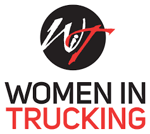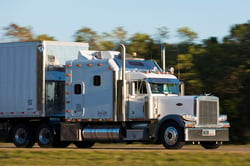Moving Forward: Women in Trucking
Carrier Relations | Agency Ownership | Logistics | Transportation | Best Practices | Freight Management | Freight Broker
March is Women's History Month, making it the perfect time to recognize women's contributions to the trucking industry, worth hundreds of billions of US dollars. Trucking alone accounts for more than 5% of all the full-time jobs in America. According to Charlotte Business Journal, women make up 47% of the workforce within the trucking industry. That includes 7% of drivers and 23% of all management roles.
 For a country so heavily dependent on truckers, there is the ever-present issue of a driver shortage. An aging driver workforce, the impact of the COVID-19 pandemic, and ongoing debates over driver pay and working hours have created challenges for the US trucking industry.
For a country so heavily dependent on truckers, there is the ever-present issue of a driver shortage. An aging driver workforce, the impact of the COVID-19 pandemic, and ongoing debates over driver pay and working hours have created challenges for the US trucking industry.
In a timely measure, the United States Senate is reintroducing a bill directed at promoting women in the trucking industry. First introduced in November 2019, the Promoting Women in Trucking Workforce Act received bipartisan support but never made it out of committee. The bill directs The Federal Motor Carrier Safety Administration to establish an advisory board focused on creating opportunities for women in the trucking industry.
 According to Women in Trucking Association (WIT) President and CEO Ellen Voie,"Although women have strengthened their presence in the supply chain in the past few years, we know there are still issues that cause women to reject a transportation career. Our goal is to better identify these concerns and address them to create a more diverse industry."
According to Women in Trucking Association (WIT) President and CEO Ellen Voie,"Although women have strengthened their presence in the supply chain in the past few years, we know there are still issues that cause women to reject a transportation career. Our goal is to better identify these concerns and address them to create a more diverse industry."
Empowering Women to Join the Ranks
A study from Northwestern University in early 2020 notes that, unlike past recessions that have typically hurt men more than women, the COVID-19 pandemic is different because it has a significant effect on occupations with high female employment shares, such as restaurants and hospitality. This unwelcome reality has the potential to increase the number of women in trucking.

While women may have previously not considered a career in Trucking, the pandemic, the hopeful passage of the Promoting Women in Trucking Workforce Act, and other factors may positively affect the number of women joining the industry.
Becoming a truck driver can be an appealing choice for women. Following are just a few of the advantages:
Competitive starting salary. According to ZipRecruiter.com, the average annual pay for an entry-level truck driver in the United States is $58,032. The average pay range for entry-level truckers varies greatly (by as much as $26,500), suggesting there may be many opportunities for advancement and increased pay based on skill level, location, and years of experience. Notably, women earn the same wages as their male counterparts since all drivers are paid the same way – by the mile, hourly, or sometimes by the load.
Opportunity abounds. Freight always needs to be moved, so there is no shortage of employment options for truckers with good records. And, statistics show that women rank higher than men when it comes to safety behind the wheel. Many women begin in trucking as a second career or even a seasonal opportunity. Organizations like Women in Trucking encourage employment, address obstacles for women in the industry, and celebrate success.
Flexibility reigns. According to a Women in Trucking’s Best Practices Survey conducted by Sawgrass Logistics and The Women in Trucking Association, women were most attracted to the “independent lifestyle, pay/benefits, and travel (w/partner).”
More Road to Pave
Of course, there are disadvantages too. According to the same Women in Trucking’s Best Practices Survey, women are often intimidated by “operating the equipment, safety on the road, getting the license, work schedule and hours, and relationship with colleagues.” Unfortunately, according to the survey, over 84% of women are not offered a mentor during training and 89% didn’t have any support after orientation. This is where advocacy groups and organizations like Women in Trucking can help pave the way for more resources to help diversity this integral part of the U.S. workforce. 
Providing additional inspiration are three women within the hierarchy of the US Department of Transportation: Meera Joshi, Acting Administrator of the Federal Motor Carrier Administration; Nuria Fernandez, Acting Administrator of the Federal Transit Administration; and Lucinda Lessley, Acting Administrator of the Maritime Administration.
American Trucking Associations (ATA) Senior Vice President Edwin Gilroy, wrote in a letter to lawmakers backing the Promoting Women in Trucking Workforce Act, “Empowering women to thrive in an industry that provides significant compensation and benefits packages achieves the twin aims of improving gender parity and tackling the growing truck driver shortage."
Want to Learn More?
At Armstrong, we value our diverse and varied workforce and partners. From agents and employees to customers and carriers, we are proud to work in an industry filled with game-changers. By celebrating, honoring, and acknowledging all women in the transportation and logistics industry, we hope to help pave the way for new talent.
If you’ve considered working in logistics or transportation, reach out to one of our recruiters to find out more about corporate positions or agency ownership.
About Brian Mann
As President and Chief Executive Officer, Brian is responsible for Armstrong’s vision, mission, and philosophy. With over 20 years of experience in logistics, Brian is an expert in supply chain optimization, operations management, air freight, freight forwarding, warehousing, customs regulations, and reverse logistics.



